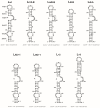RNA Structural Requirements for Nucleocapsid Protein-Mediated Extended Dimer Formation
- PMID: 35337013
- PMCID: PMC8953772
- DOI: 10.3390/v14030606
RNA Structural Requirements for Nucleocapsid Protein-Mediated Extended Dimer Formation
Abstract
Retroviruses package two copies of their genomic RNA (gRNA) as non-covalently linked dimers. Many studies suggest that the retroviral nucleocapsid protein (NC) plays an important role in gRNA dimerization. The upper part of the L3 RNA stem-loop in the 5' leader of the avian leukosis virus (ALV) is converted to the extended dimer by ALV NC. The L3 hairpin contains three stems and two internal loops. To investigate the roles of internal loops and stems in the NC-mediated extended dimer formation, we performed site-directed mutagenesis, gel electrophoresis, and analysis of thermostability of dimeric RNAs. We showed that the internal loops are necessary for efficient extended dimer formation. Destabilization of the lower stem of L3 is necessary for RNA dimerization, although it is not involved in the linkage structure of the extended dimer. We found that NCs from ALV, human immunodeficiency virus type 1 (HIV-1), and Moloney murine leukemia virus (M-MuLV) cannot promote the formation of the extended dimer when the apical stem contains ten consecutive base pairs. Five base pairs correspond to the maximum length for efficient L3 dimerization induced by the three NCs. L3 dimerization was less efficient with M-MuLV NC than with ALV NC and HIV-1 NC.
Keywords: HIV-1; RNA dimerization; RNA secondary structure; Rous sarcoma virus (RSV); nucleocapsid protein; retrovirus.
Conflict of interest statement
The authors declare no conflict of interest.
Figures








Similar articles
-
Structural requirements for nucleocapsid protein-mediated dimerization of avian leukosis virus RNA.J Mol Biol. 2007 Sep 28;372(4):1082-1096. doi: 10.1016/j.jmb.2007.07.026. Epub 2007 Jul 26. J Mol Biol. 2007. PMID: 17706668
-
Identification of a high affinity nucleocapsid protein binding element within the Moloney murine leukemia virus Psi-RNA packaging signal: implications for genome recognition.J Mol Biol. 2001 Nov 23;314(2):217-32. doi: 10.1006/jmbi.2001.5139. J Mol Biol. 2001. PMID: 11718556
-
Characterization of loose and tight dimer forms of avian leukosis virus RNA.J Mol Biol. 2000 Jun 30;300(1):41-56. doi: 10.1006/jmbi.2000.3832. J Mol Biol. 2000. PMID: 10864497
-
Conserved determinants of lentiviral genome dimerization.Retrovirology. 2015 Sep 29;12:83. doi: 10.1186/s12977-015-0209-x. Retrovirology. 2015. PMID: 26420212 Free PMC article.
-
HIV-1 RNA dimerization: It takes two to tango.AIDS Rev. 2009 Apr-Jun;11(2):91-102. AIDS Rev. 2009. PMID: 19529749 Free PMC article. Review.
References
MeSH terms
Substances
LinkOut - more resources
Full Text Sources

